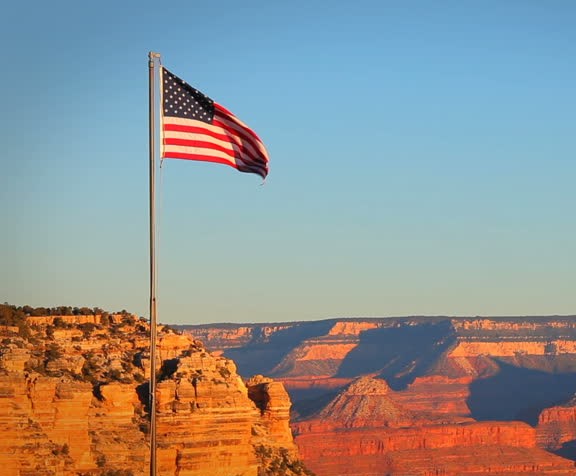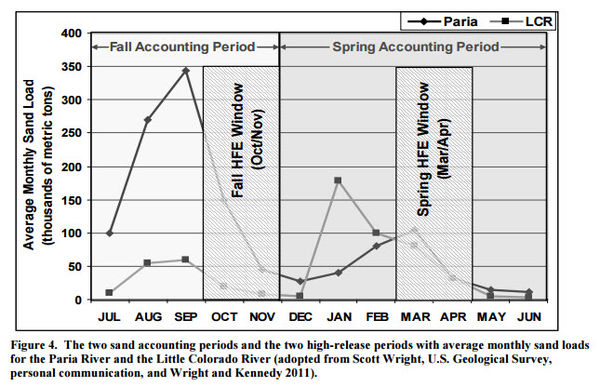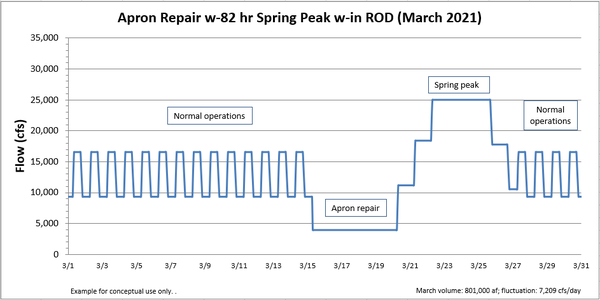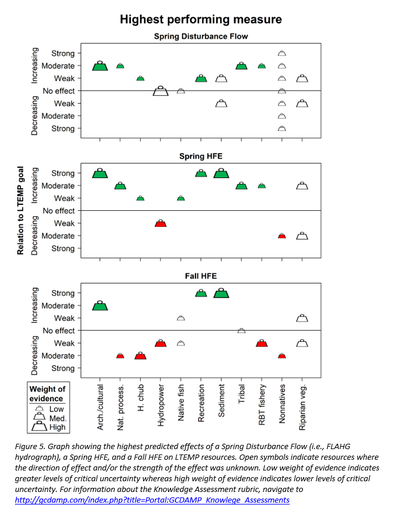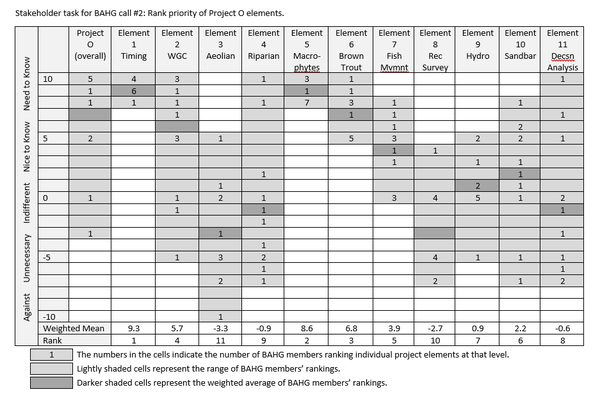Difference between revisions of "GCDAMP FLAHG Page"
Cellsworth (Talk | contribs) |
Cellsworth (Talk | contribs) |
||
| Line 52: | Line 52: | ||
|- | |- | ||
|style="color:#000;"| | |style="color:#000;"| | ||
| + | |||
| + | To test both spring and fall HFEs, the HFE protocol proposed using two sediment accounting periods. | ||
| + | These sediment accounting periods are used to track the quantity of new Paria River sand available for | ||
| + | building beaches in Marble Canyon during an HFE, and HFEs are only triggered if the quantity of new | ||
| + | sand is large. This sediment accounting approach to triggering HFEs, coupled with state-of-the-art | ||
| + | sediment monitoring (Topping and Wright 2016), eliminates the possibility of unintentionally scouring | ||
| + | sediment resources from Marble Canyon during HFEs. When the HFE protocol was first proposed, it was | ||
| + | estimated that sediment-triggered fall HFEs would occur approximately two out of every three years and | ||
| + | sediment-triggered spring HFEs would occur approximately once every three years (Wright and Kennedy | ||
| + | 2011). [http://gcdamp.com/images_gcdamp_com/3/30/A3_-_20201006_-_FLAHG_Predicted_Effects.v5.Oct5.pdf] | ||
[[File:HFE windows.jpg|center|600px]] | [[File:HFE windows.jpg|center|600px]] | ||
| + | Although Sediment-Triggered Spring HFEs and Proactive Spring HFEs are now possible, analysis of Paria | ||
| + | River discharge data indicates that Sediment-Triggered Spring HFEs may occur less frequently than | ||
| + | originally estimated (Grams and Topping 2018). Sediment accounting data available since the HFE | ||
| + | protocol was operationalized in 2012 bear this out. Specifically, since 2012 the sediment trigger for a fall | ||
| + | HFE has been reached 6 times (i.e., 2012-2016, 2018; no HFE occurred in 2015 owing to green sunfish) | ||
| + | while the sediment trigger for a spring HFE has never been reached (Grams and Topping 2020). Testing | ||
| + | of 5 fall HFEs over the past 8 years has benefitted sediment resources and reduced uncertainties | ||
| + | concerning sandbar response to HFEs in general (Figure 2). However, regular testing of fall HFEs since | ||
| + | 2012 is also correlated with a growing population of brown trout in Lees Ferry (Runge and others 2018) | ||
| + | and critical uncertainties concerning the role of spring HFEs in achieving biological resource objectives | ||
| + | remain unanswered (Figure 2). | ||
| + | |||
| + | By May 2020, the FLAHG and GCMRC completed design of a conceptual hydrograph that included a high | ||
| + | spring release that was within power plant capacity. The FLAHG hydrograph capitalizes on a unique low | ||
| + | flow of 4,000 ft3 /s for 5 days, which is needed to conduct maintenance on the apron of Glen Canyon | ||
| + | Dam (see Figure 3). The FLAHG hydrograph proposes to follow this low flow disturbance with a high flow | ||
| + | disturbance that will culminate in a discharge of up to 25,000 ft3 /s for 82 hours. This combination of | ||
| + | desiccation at low flows followed by scour at high flows is hypothesized to disturb benthic habitats to a | ||
| + | much greater extent than either the low or high flows alone (Kennedy and others 2020). [http://gcdamp.com/images_gcdamp_com/3/30/A3_-_20201006_-_FLAHG_Predicted_Effects.v5.Oct5.pdf] | ||
[[File:FLAHG_hydrograph.png|center|600px]] | [[File:FLAHG_hydrograph.png|center|600px]] | ||
| + | Below we present predicted effects of the FLAHG hydrograph on the 11 LTEMP Resource Goals using the | ||
| + | Knowledge Assessment rubric from 2019 | ||
| + | (http://gcdamp.com/index.php?title=Portal:GCDAMP_Knowlege_Assessments). For comparison, and to | ||
| + | anchor predictions concerning the FLAHG hydrograph, we also used the Knowledge Assessment | ||
| + | framework to predict effects of Spring and Fall HFEs on LTEMP Resource Goals. To simplify analysis of | ||
| + | hydrograph impacts, the FLAHG narrowed consideration of testing this hydrograph to sometime in | ||
| + | March based on the following two main reasons: 1) both the 1996 and 2008 Spring HFEs also occurred in | ||
| + | March, which will simplify evaluation and comparison of new biological data that might be collected | ||
| + | around a FLAHG hydrograph to earlier data from those spring HFEs, and 2) a March test of the FLAHG | ||
| + | hydrograph will minimize adverse impacts of the low flow to Recreational Experience by avoiding the | ||
| + | start of the commercial river trip motor season in April. | ||
| + | |||
| + | Knowledge Assessment groups often evaluated multiple specific measures to capture all the facets of a | ||
| + | given LTEMP goal. For example, the goal for Rainbow Trout Fishery is, “Achieve a healthy high-quality | ||
| + | recreational rainbow trout fishery in GCNRA and reduce or eliminate downstream trout migration | ||
| + | consistent with NPS fish management and ESA compliance.” To capture both facets of this goal, the | ||
| + | Knowledge Assessment team considered two specific measures: rainbow trout abundance in Lees Ferry, | ||
| + | and rainbow trout abundance at the Little Colorado River confluence. The predicted resource responses | ||
| + | to a given action often varied, depending on which specific measure was considered. We capture this | ||
| + | variation in predictions by presenting bookend, “lowest performing” and “highest performing”, | ||
| + | scenarios gleaned from the assessments and their differing specific measures. Note that the assessment | ||
| + | summaries and graphs are based on detailed assessments for each resource that were performed by | ||
| + | multiple subject matter experts (see section V. Acknowledgements for a complete list of participants). | ||
| + | Those detailed assessments are contained in a spreadsheet for each resource that accompany this | ||
| + | document. The detailed resource assessments were based on consideration of peer-reviewed literature, | ||
| + | modelling, and other quantitative science as well as more qualitative expert opinions, similar to previous | ||
| + | Knowledge Assessments. [http://gcdamp.com/images_gcdamp_com/3/30/A3_-_20201006_-_FLAHG_Predicted_Effects.v5.Oct5.pdf] | ||
[[File:PredictedEffectsLowest.png|left|400px]] | [[File:PredictedEffectsLowest.png|left|400px]] | ||
Revision as of 17:23, 24 November 2020
|
|
Flow Experiments Ad Hoc Group (FLAHG)ESTABLISHED JANUARY 15, 2020, Status: Active ChargeIn accordance with direction provided by the AMWG at its August 18, 2018 meeting, and the Secretary Designees August 14, 2019 guidance to BOR and GCMRC, the FLAHG is charged with working with GCMRC to evaluate opportunities for conducting higher spring releases that may benefit high value resources of concern to the GCDAMP (recreational beaches, aquatic food base, rainbow trout fishery, hydropower, humpback chub and other native fish, cultural resources, and vegetation), fill critical data gaps, and reduce scientific uncertainties. As a starting point, the FLAHG shall consider the benefits of and opportunities for conducting higher spring releases within power plant capacity. The FLAHG and GCMRC will report their initial findings to the TWG in April 2020 so that the TWG and GCMRC can report their conclusions to the AMWG in May 2020. The FLAHG is also charged with working with GCMRC to develop and propose a project element in the FY 2021-2023 Triennial Budget and Work Plan to identify other spring high flow options that may be allowed under the current LTEMP ROD (as determined by DOI) that may benefit high valued resources of concern to the GCDAMP (defined above), fill critical data gaps, and reduce scientific uncertainties. MembersPeggy Roefer (chair), Jeff Arnold, Jan Balsom, Cliff Barrett, Rob Billerbeck, David Brown, Peter Bungart, Kelly Burke, Shane Capron, Winkie Crook, Craig Ellsworth, Charlie Ferrantelli, Clarence Fullard, Michelle Garrison, Paul Harms, Brian Healy, Leslie James, John Jordan, Vineetha Kartha, Ted Kennedy, Jakob Maase, Ryan Mann, Craig McGinnis, Jessica Neuwerth, Clayton Palmer, Bill Persons, Richard Powskey, Ben Reeder, Peggy Roefer, Scott Rogers, Seth Shanahan, Larry Stevens, Jim Strogen, Lee Traynham, Steve Wolff, Kirk Young. Invited technical advisors: Helen Fairley, Heather Patno, Mike Moran, Scott VanderKooi |
| -- |
-- |
-- |
|---|
|
|
